Cards In This Set
| Front | Back |
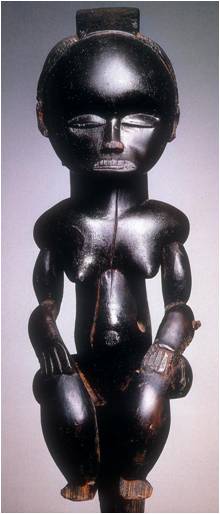 --- |
Fang
Mbobeyima (Wood
Carver)
“Black Venus” (Nlo Bieri)
Gabon
19th c.
Wood, pigment (copal resin & palm oil)
It's made as a seated female with an emphasis on the the belly button to signify the umbilical cord which connects them to ancestors. It has northern fang style of elongated proportions, and spherical head. It was made as a reliquary figure to guard ancestral skulls. |
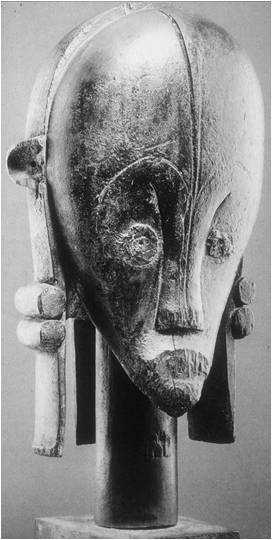 - |
Fang
Mbobeyima (Wood
Carver)
“The Great Bieri” (Nlo Bieri)
Gabon
Before 1900
Wood, pigment (copal resin & palm oil)
It is heart shaped Reliquary figure made to gaurd ancestral skulls, and used as a mediator between the living and dead(wood with metal eyes). It is made for a new family or unity to bring power and prosperity but not really empowered until first founder dies. |
 - |
Fang
Mbobeyima (Wood
Carver)
Nlo Bieri
Gabon
19th c.
Wood, pigment, brass
Reliquary guardian used to warn women, children and uninitiated. It is also used as a medium for ancestral spirit to mediate between living and the dead. It looks strong, quiet, and reflective to show its reflecting on the problems of the community since it is consulted before any important undertaking. It is also |
 - |
Kota
Mbulu Ngulu
Gabon
19th c.
Wood, copper, brass
Diamond shaped image of the spirit of the death, meant to be a mediator between the living and the death as well as a guardian that protects relics from witchcraft. It was used to represent a clan and was bought out during difficult times. It given the color of red to signify its color and is made shiny to deflect evil forces. |
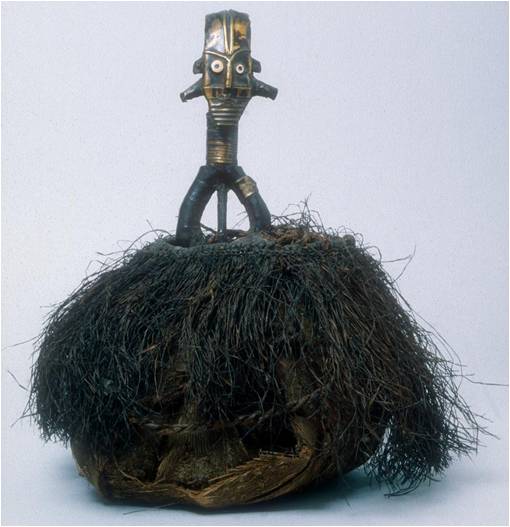 - |
Kota
Bwiti
Gabon
19th c.
Wood, copper, brass
When Mbulu Ngulu became outlawed Bwiti (more figural) became more popular because of its smaller size. |
 - |
Hongwe
Bweti
Gabon
19th c.
Wood, copper, brass
Leaf shaped reliquary designed to protect and benefit the families that own them (kept in the possession of the chief. They have Hongwe features such as an oval, concave face with a cylinder face and no mouth. This relic is known to be dangerous to handle because of their role in funeral rites. |
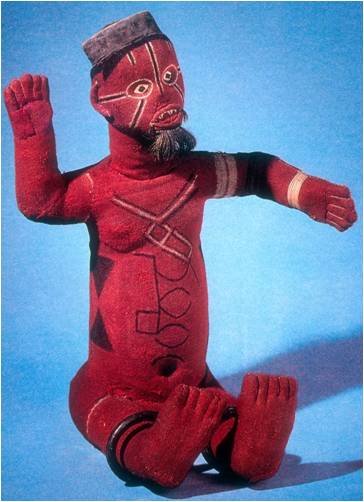 - |
Bembe (Kongo)Nganga
Muzidi
DRC 19th-20th c. Cane, dried leaves, reliquary bones, cloth, pigmentCan be interpreted as mannequin and is used to place the bones of deceased important ancestors. It is made of can armature and stuffed with banana leaves and reliquary bundles. It is kept in a grave house and brought out to settle difficult matters. It is in a seated pose because it is meant to represent a noble person such as a king or chief who are buried in a seated posture.. |
 - |
Bwende (Kongo)
Nganga
Niombo
DRC
19th-20th c.
Cane, preserved human remains, cloth, pigment
Made for the most powerful and famous leaders. It is a larger than life smoke dried body wrapped in raffia and covered in red cloth to symbolize power and chieftaincy. The codes on the Niombo are intermediary signs used to communicate to ancestors and asking them to accept the person. |
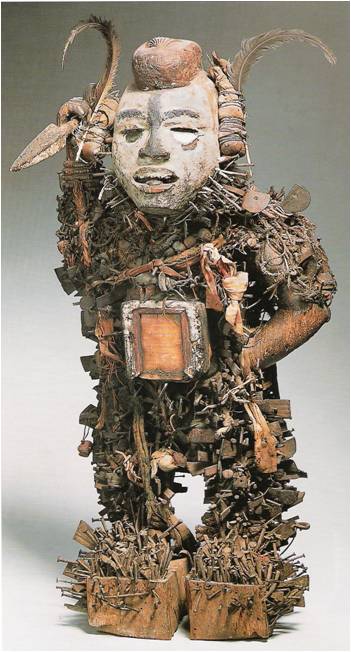 - |
Kongo
Nganga
Nkisi Nkondi
DRC
19th c.
Wood, iron, mixed media
It is made to harness the powers of spirits (bakisi) and is used to deflect malevolent forces( covered my mirrors or other reflective material) and frighten witches.The stomach emphasizes due to it representing a spiritual seat. It is also made with kaolin clay (dead live in ancestral waters) and is the white color of the dead). |
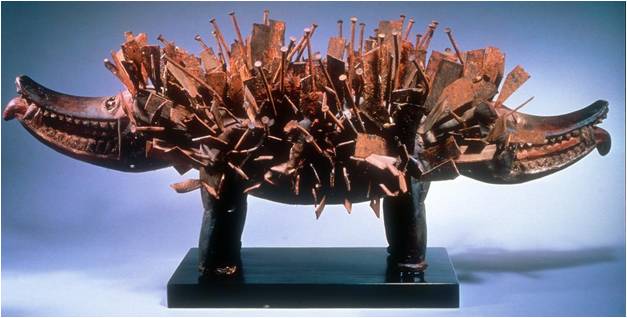 - |
Kongo
Nganga
Kozo (Nkisi Nkondi)
DRC
19th c.
Wood, iron, pigment
This functions as a witch hunter (dogs are great hunters) They are Janus-faced since they are all-seeing which means they can see in both worlds and can communicate with the death and living (intermediary). They became scarce after colonials outlawed/destroyed them. |
 - |
Kongo
Nganga
Nkisi “Of the Below”
DRC
19th c.
Wood, feathers, claws, pigment, fiber
They are containers for medicines attributed to women's affairs and health and cures diseases associated with reproduction. They are also associated with earth and rivers and are made with various items such as sea shells and clay pots. |
 - |
Kongo
Nganga (and blacksmith)
Crucifix
DRC
16th-18th c.
Brass
The crucifix were made with European characteristics such as the lion cloth and ribs. It is indigenous through the emphasis the bellybutton because is the seed of the soul. The facial features are also more abstract to show its spiritual aspects. The crucifix were used as for healing rites or hunting amulets. |
 - |
Kongo
Nganga (and blacksmith)
Crucifix
DRC
16th-18th c.
Wood, brass
The crucifix we made with European characteristics such as the lion cloth and ribs. Through indegious influence the facial features are more abstract to show its spirituality. The cross is an indigenous symbol for crossroads ( relationship between ancestors and humans). It represents the sacred place where humans and spirits come together for rituals and prayer. |
 - |
Kongo
Nganga
Toni Malau
DRC
17th-18th c.
Wood
The art pieces focuses on St. Anthony of Padua who was a traditional protector of children and mothers and associated with females. It is shown holding Jesus(with African features) sitting cross legged with a royal fly whisk representing a Kongo king. It can be used as protection from illness and as a figure for healing and protection. |
 - |
Eastern Pende
Mbembo
Pumbu mask
DRC
20th c.
Wood, pigment, raffia fiber
The Pumbu is known as the executioner mask. It has projecting eyes (anger and aggression) and white rims (ancestral power and death). It is considered the most dangerous and is a symbol of chiefly power. The Pumbu rarely dances and only dances in grave occasions (divination). During the dance he is restrained with rope because of its need to kill. It is a symbol of chief's power to confront difficult decisions. |



